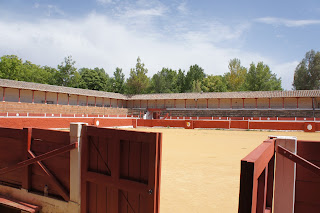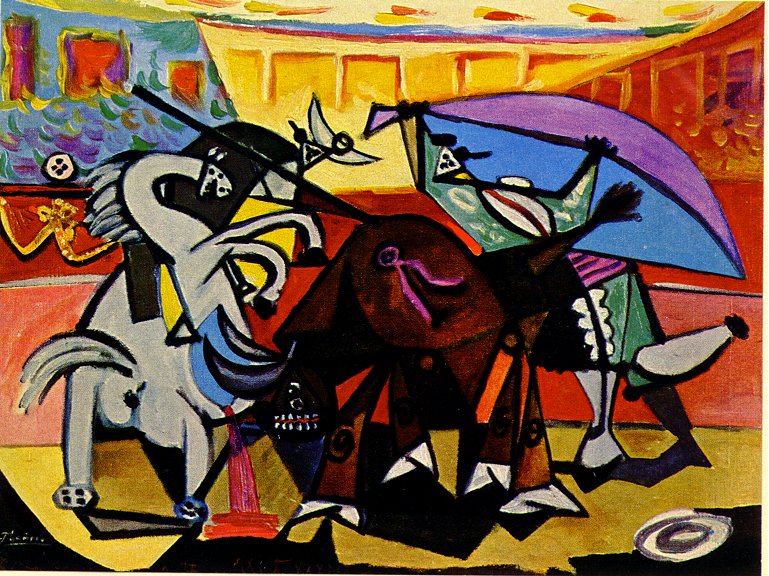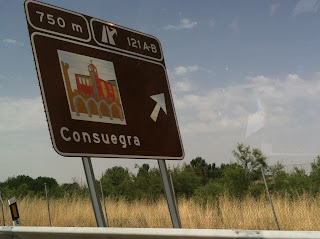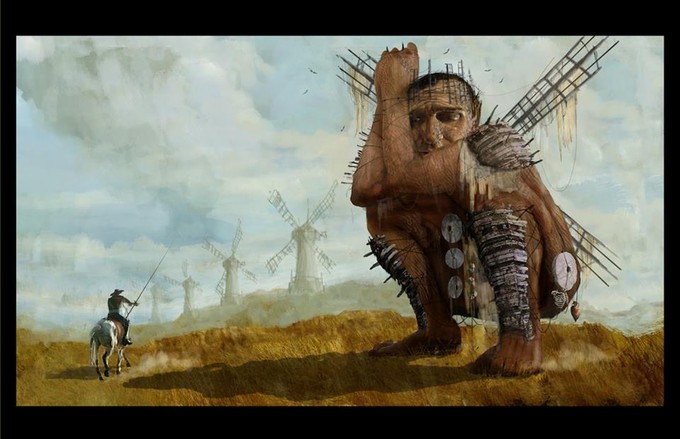Ok, so I am digressing slightly again since Don Quijote does not stop here or live here or love someone from here, but I can make a connection. The city has its obligatory sign and mention of the famous knight at the entrance, but beyond that, you will not find the same number of Don Quijote sites as in other places. There is no Quijote Burger here. However, there is a clear connection to Cervantes, which I will explain shortly. I should also mention that this is not the easiest place to reach via public transportation from Madrid (otherwise, my husband would have already been here), so if you have a car and are driving through La Mancha, it really is a required stop.
The next stop on our trip was the city of Viso del Marques a little farther south of the windmills and bullring. You'll notice it is pretty much the end of La Mancha. Once you cross the dotted line (the mountains) you reach Jaen, which is where we spent some time as well. I'll talk about Baeza and Ubeda later.

The reason we went to this small town in the far south of La Mancha was to see the Palacio del Marques de Santa Cruz Archivo General de la Marina. That is, the palace of the Marquis of Santa Cruz's General Marine Archive and Museum. Now, if you look back at the map, you may be surprised to find a naval or marine museum in the middle of nothing but dry land. For us, it was reminiscent of the The National Museum of the Pacific War in Fredericksburg, Texas that we visited years ago while living in Austin.

You would expect A National Museum of the Pacific War to be in Hawaii or maybe California or a place like D.C. or New York maybe. Instead, it is in the middle of Texas.
Why? Because Admiral Nimitz was from Fredericksburg. Admiral Nimitz was a war hero and naval expert during WWII, so they opened the museum in his hometown as a way to honor him and all of the men and women who served under him in the Pacific Theater.
So, like the Naval Museum in La Mancha, it seems out of place at first.
The story of the Palacio del Marques is similar. Alvaro de Bazan was the first Marques de Santa Cruz de Mudela (the town later changed the name to Viso de Marques, something like the Jewel of the Marquis) and the one who built the palace and collected the items for the museum and later archive.
The building was constructed around 1574-1588 and became a National Monument in 1931. Wikipedia (not maybe the best source, but the easiest to understand with my limited Spanish) claims that while the Marquis of Santa Cruz owns the palace, the Spanish Navy rents it for a
peseta (like $1) a year.
 |
| The Facade |
 |
| An inscription by Lope de Vega about the Battle of Lepanto |
 |
| A statue of the Marquis |
 |
| cuddling by a cannon? sure, why not? |
 |
| you can tell it's a navy museum! |
 |
| we didn't get to see the gardens really, but you can peek through the gate to see they are there |
 |
| my husband's artsy photo |
Now, this museum is supposed to be quite impressive with frescos of naval battles, mythology, military paintings, etc. Sadly, we did not time our visit well and just missed it on Sunday. It was closed on Monday, and we simply did not have the time to drive all the way back to make it on Tuesday. So, I never actually saw the museum! We are definitely going back! We did get to see the outside, which is quite beautiful in and of itself since it is a palace after all.



So, the reason I mention this naval museum and the first Marquis of Santa Cruz, Alvaro de Bazan, is because he led the Spanish forces at the Battle of Lepanto. Since I am not a historian or military expert, here is the Wikipedia excerpt:
"The
Battle of Lepanto took place on 7 October 1571 when a fleet of the
Holy League, a coalition of southern European
Catholic maritime states, led by
Spain decisively defeated the fleet of the
Ottoman Empire on the northern edge of the
Gulf of Corinth, off western
Greece. The Ottoman forces sailing westwards from their naval station in
Lepanto (
Turkish:
İnebahtı;
Greek:
Ναύπακτος or Έπαχτος Naupaktos or Épahtos) met the Holy League forces, which came from
Messina,
Sicily, where they had previously gathered. The victory of the Holy League prevented the Ottoman Empire from
expanding further along the European side of the Mediterranean. Lepanto
was the last major naval battle in the Mediterranean fought entirely
between
galleys and has been assigned great symbolic and historical importance by several historians.
[9][10][11]"
While I do not always trust Wikipedia, the references for 9,10, and 11 for this excerpt are Oxford Press books, so hopefully this is accurate. Based on a few glances at other websites and books on Amazon, the information seems consistent enough and explained in easy terms for my non-military brain to understand.
 |
| Inside the museum |
The reason we should care about this old battle between Spain and the Ottoman Empire is that both the Marquis of Santa Cruz and Cervantes fought in this battle. Miguel Cervantes
received permanent wounds in the battle, something of which he was very proud and mentions this fact in the beginning og Part II. The loss of the use of his left hand led to the nickname
el manco de Lepanto (the one-handed man of Lepanto). Fortunately, he was right-handed and still able to write!
The Marquis was leading, and Cervantes was a soldier, so I doubt they knew each other. Still, stopping at this naval museum can perhaps give a better understanding of the significance of this battle for Cervantes, the experience of fighting in the battle, and the character in the novel based on Cervantes' own experience as a Christian sailor/soldier and captive held by Algerians. The autobiographical nature of this story line deserves an entire post now that I look back at it. He pretty much tells his own story through this character.
I will then talk about the crocodile and the church and save more about Cervantes' military experience later!
 |
| Iglesia de Nuestra Señora de la Asunción |
 |
| Yep, that's a real crocodile on the wall |
 |
| close up |
 |
| the church |
 |
| the lamps from his ship |
The church Our Lady of the Ascension was also paid for and built by the Marquis of Santa Cruz, Alvaro de Bazan, for the city. It is a Gothic-Renaissance built a little earlier than the palace, about a century. It was built over the remains of an older church. On one of the Marquis' expeditions, he went to Egypt and visited the Nile River. According to the priest we spoke to at the church, the crocodile from the Nile was brought back alive when it was small. They kept it in the church until it grew up and eventually died. Then, they stuffed it and put it on the wall. The crocodile has little to do with Don Quijote and did not eat Cervantes' left hand, but I find it a fascinatingly unique part of this little church and town. The lamps in the church are also interesting because they were from the Marquis' ships.

 The reason we went to this small town in the far south of La Mancha was to see the Palacio del Marques de Santa Cruz Archivo General de la Marina. That is, the palace of the Marquis of Santa Cruz's General Marine Archive and Museum. Now, if you look back at the map, you may be surprised to find a naval or marine museum in the middle of nothing but dry land. For us, it was reminiscent of the The National Museum of the Pacific War in Fredericksburg, Texas that we visited years ago while living in Austin.
The reason we went to this small town in the far south of La Mancha was to see the Palacio del Marques de Santa Cruz Archivo General de la Marina. That is, the palace of the Marquis of Santa Cruz's General Marine Archive and Museum. Now, if you look back at the map, you may be surprised to find a naval or marine museum in the middle of nothing but dry land. For us, it was reminiscent of the The National Museum of the Pacific War in Fredericksburg, Texas that we visited years ago while living in Austin. You would expect A National Museum of the Pacific War to be in Hawaii or maybe California or a place like D.C. or New York maybe. Instead, it is in the middle of Texas.
You would expect A National Museum of the Pacific War to be in Hawaii or maybe California or a place like D.C. or New York maybe. Instead, it is in the middle of Texas.




























































